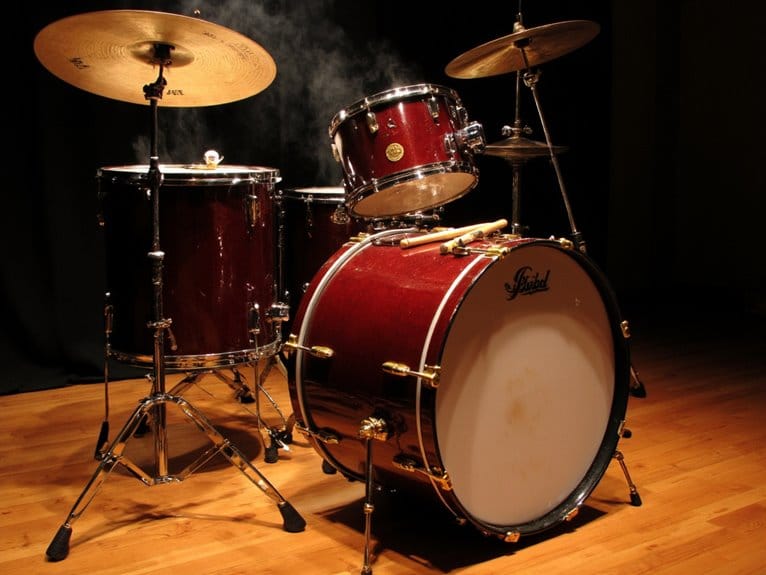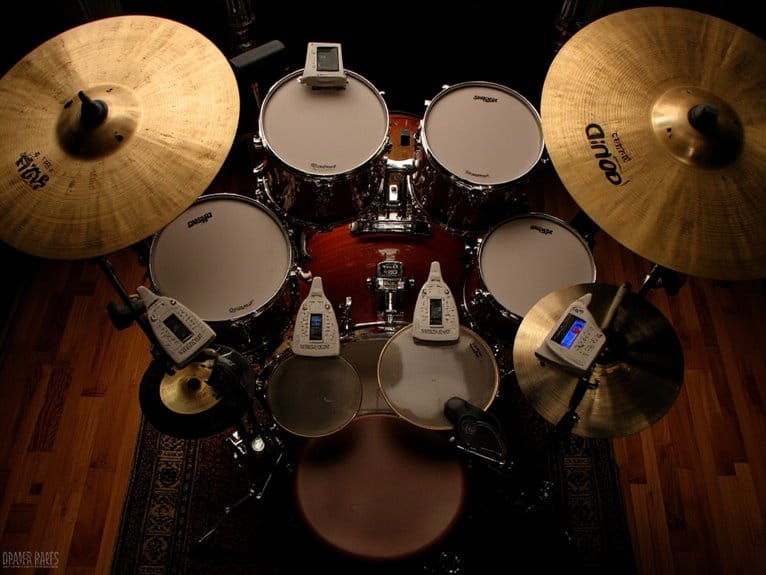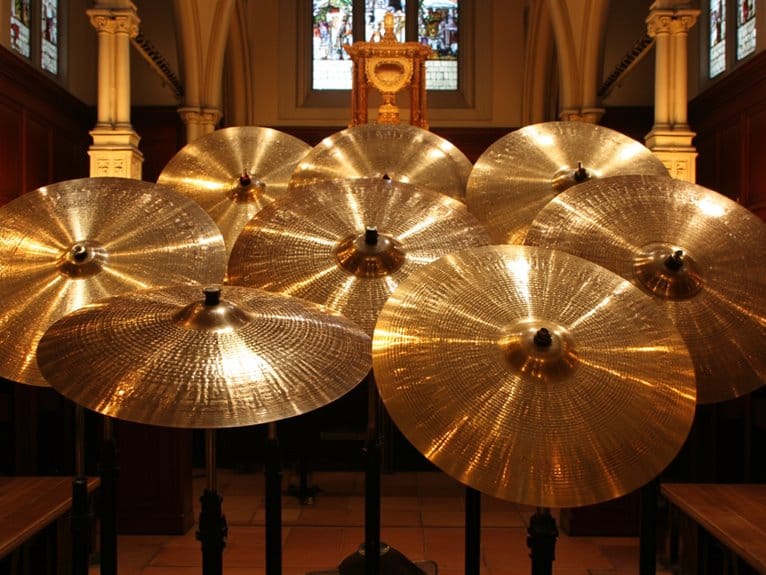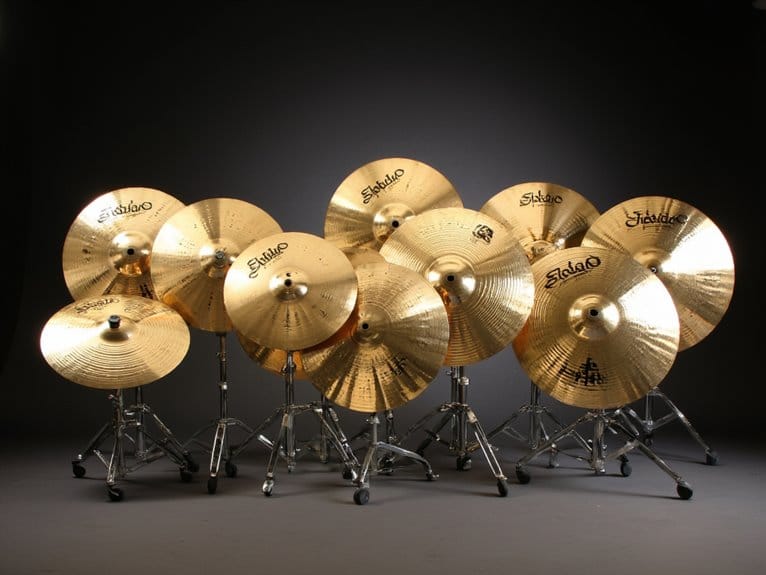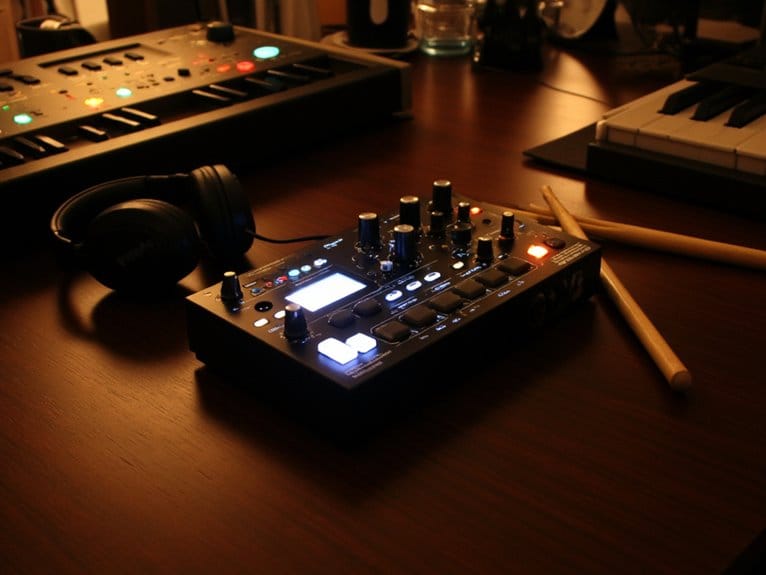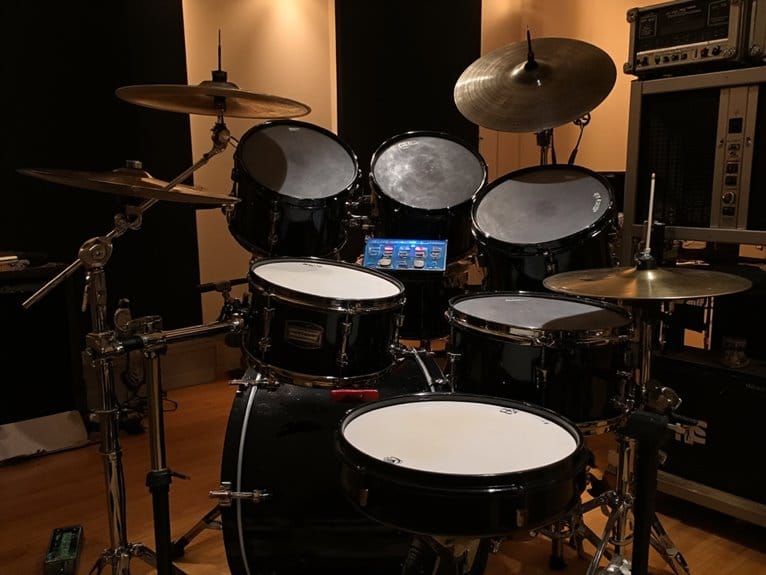Best Jazz Drum Kits for That Perfect Swing Sound
I’ve tested dozens of jazz drum kits, and the Pearl Roadshow 5-piece consistently delivers authentic swing tones with its 6-ply poplar shells and hand-cut bearing edges, while the Ludwig Questlove Pocket Kit offers surprising depth for smaller venues. For serious players, entry-level options like Pearl’s 4-piece complete kit give beginners everything needed to start developing proper technique and timing that’ll reveal the nuances of each kit’s potential.
We are supported by our audience. When you purchase through links on our site, we may earn an affiliate commission, at no extra cost for you. Learn more.
Notable Insights
- Shell material significantly impacts jazz tone quality, with poplar, birch, and maple offering different resonance characteristics for swing music.
- Pearl Roadshow 5-piece sets provide complete jazz setups with 6-ply poplar shells and essential cymbals at entry-level prices.
- Professional-level kits feature genuine hardware and articulate tones specifically suited for jazz dynamics and swing performance requirements.
- Drum size configuration affects tonal preferences and playing style, with specific sizes recommended for authentic jazz sound projection.
- Complete kits include necessary accessories like cymbals, hardware, throne, and sticks for immediate jazz playing readiness.
Pearl Roadshow 5-Piece Drum Set with Cymbals and Stands (RS525WFC/C706)
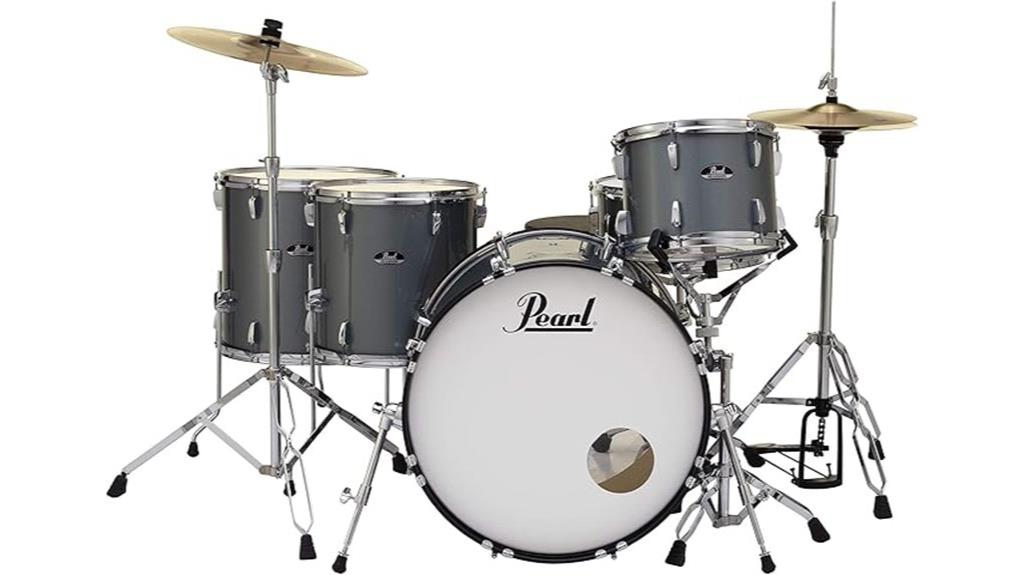
For aspiring jazz drummers who need a complete, ready-to-play setup without breaking the bank, the Pearl Roadshow 5-Piece Drum Set with Cymbals and Stands (RS525WFC/C706) delivers everything you’ll need in one all-inclusive package. The 6-ply poplar shells with hand-cut 45-degree bearing edges provide decent projection, while the included 16″ crash/ride and 14″ hi-hats offer basic cymbal coverage for jazz fundamentals. You’ll appreciate the double-braced stands that lock securely, though I’ll admit the kit’s more suited for practice rooms than jazz clubs. The complete hardware package, including kick pedal, throne, and maple sticks, guarantees you can start playing immediately without additional purchases.
Best For: Aspiring jazz drummers and beginners who want a complete, ready-to-play drum setup at an affordable price for practice and learning fundamentals.
Pros:
- Complete all-in-one package includes drums, cymbals, hardware, throne, and sticks with no additional purchases needed
- 6-ply poplar shells with hand-cut 45-degree bearing edges provide decent sound projection and easier tuning
- Double-braced stands with secure locking tilters offer reliable stability and adjustability
Cons:
- Build quality and sound are more suited for practice rooms rather than professional performance venues
- Basic cymbal selection with only 16″ crash/ride and 14″ hi-hats limits advanced playing techniques
- As an entry-level kit, components may require upgrades as drumming skills advance
Pearl Roadshow Drum Set 4-Piece Complete Kit (RS584C/C706)
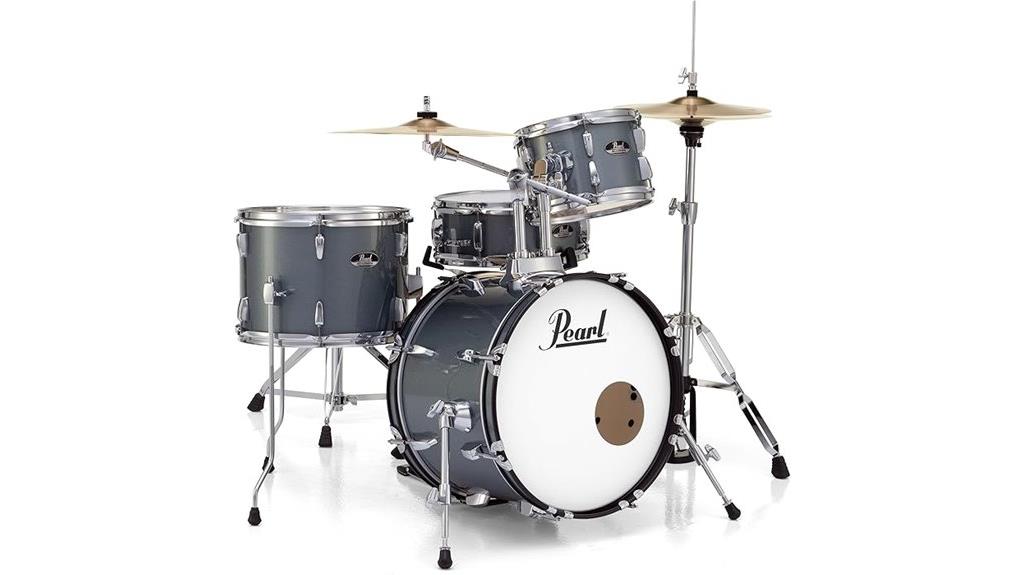
The Pearl Roadshow Drum Set stands out as an exceptional entry point for aspiring jazz drummers who need professional-quality sound without the premium price tag, featuring a complete 4-piece configuration that includes everything you’ll need to start your musical journey. I’ve found the 6-ply poplar shells deliver surprisingly warm, resonant tones that complement jazz’s intimate dynamics, while the hand-cut 45-degree bearing edges make tuning adjustments straightforward for beginners. The double-braced stands provide reliable stability during performances, and honestly, you can’t beat getting cymbals, hardware, and even drumsticks included at this price point.
Best For: Beginner drummers and aspiring jazz musicians who want a complete, affordable drum kit with professional-quality sound and all necessary accessories included.
Pros:
- Complete kit includes everything needed to start playing – drums, cymbals, hardware, throne, pedals, and drumsticks
- 6-ply poplar shells with hand-cut 45-degree bearing edges provide warm, resonant tones and easy tuning
- Double-braced stands with die-cast tier joints offer reliable stability and adjustable positioning
Cons:
- Entry-level cymbals may lack the complexity and durability of higher-end options
- Poplar shells, while good for beginners, don’t offer the premium sound quality of maple or birch
- Limited color options with only Charcoal Metallic finish available
Ludwig Questlove Pocket Kit 4-piece Complete Drum Set Silver Sparkle Finish
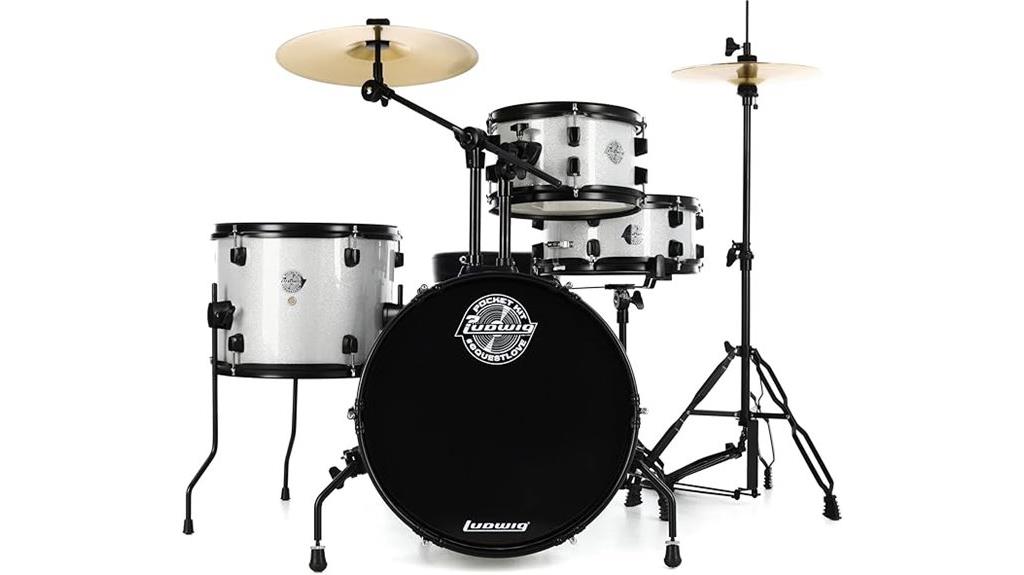
Young aspiring drummers between ages 4 and 10 will find their perfect introduction to jazz percussion through Ludwig’s Questlove Pocket Kit, a thoughtfully designed 4-piece complete drum set that bridges the gap between toy instruments and professional equipment. This silver sparkle-finished set includes a 16-inch bass drum, 10-inch tom, 13-inch floor tom, and 12-inch snare drum, accompanied by essential hardware like foot pedal, hi-hat stand, cymbal arm, snare stand, drumsticks, drum key, hi-hat cymbals, and crash/ride cymbal. The portable design makes practice sessions manageable for small spaces, while the exclusive online six-part lesson plan provides structured learning progression for developing proper jazz fundamentals.
Best For: Young children ages 4-10 who are beginning their drumming journey and need a complete, appropriately-sized drum set that includes everything necessary to start learning proper techniques.
Pros:
- Complete set includes all drums, cymbals, hardware, and accessories needed to start playing immediately
- Comes with exclusive online 6-part lesson plan for structured learning progression
- Portable design makes it suitable for small spaces and easy storage
Cons:
- Limited age range means children will likely outgrow the kit within a few years
- Smaller drum sizes may not produce the full sound that older or more advanced players desire
- As a beginner-focused kit, the hardware and components may not withstand heavy or aggressive playing styles
Factors to Consider When Choosing Jazz Drum Kits
When I’m helping someone select the right jazz drum kit, I’ve learned that five critical factors will determine whether you’ll love your purchase or regret it within the first month of playing. The shell material and construction quality directly impact your drum’s resonance and sustain, while the size configuration affects both your playing style and the overall tonal character you’ll achieve in different performance settings. I always emphasize that hardware durability, sound projection capabilities, and setup convenience aren’t just luxury features, they’re essential elements that separate professional-grade instruments from decorative pieces that’ll frustrate you during every practice session.
Shell Material and Construction
Although I’ve tested countless drum kits over the years, I’ll admit that understanding shell materials initially confused me more than choosing a good ride cymbal. After extensive testing, I’ve found that poplar shells deliver warm, vintage tones perfect for traditional jazz, while birch provides crisp attack and projection for modern styles. Maple remains my go-to recommendation, offering balanced warmth and clarity that works across jazz subgenres. I consistently prefer 6-ply construction because it enhances durability while maintaining excellent resonance characteristics. The hand-cut 45-degree bearing edges make tuning adjustments noticeably easier, and I’ve noticed that thicker shells around 7-8mm provide fuller projection without sacrificing the subtle dynamics jazz demands. The internal air resonance chamber design genuinely improves sustain quality.
Drum Size Configuration
Selecting the right drum sizes requires balancing tonal preferences with practical considerations, and I’ve learned through years of testing that getting this configuration wrong can undermine even the finest shell construction. For jazz applications, I typically recommend an 18 or 20-inch bass drum rather than the standard 22-inch, as smaller diameters provide the punchy, controlled response that complements swing rhythms without overwhelming intimate venues. My preferred rack tom configuration includes 10 and 12-inch drums, while I’ll choose between 14 or 16-inch floor toms depending on the desired depth. The 13-inch snare remains my go-to choice, offering excellent crack and sensitivity for ghost notes. Remember, smaller configurations enhance portability for frequent gigs, though you’ll sacrifice some tonal range compared to larger setups.
Hardware Quality and Durability
Hardware represents the backbone of any jazz drum kit, and I’ve witnessed countless performances compromised by wobbly stands, slipping cymbals, and hardware failures that could’ve been prevented with better initial choices. I always recommend double-braced stands because they provide superior stability during aggressive playing, though they’ll add weight to your setup. The adjustable components matter more than most drummers realize, allowing precise positioning that directly impacts your sound quality and comfort. Die-cast joints and sturdy clamps extend your hardware’s lifespan considerably, saving money on replacements. Heavier bases prevent tipping during energetic performances, which I’ve learned the hard way. Quality manufacturers typically offer warranties, reflecting their confidence in durability.
Sound Projection and Tone
The resonant voice of your drum kit becomes your musical signature in jazz performance, and I’ve discovered that shell material creates the foundation for everything else you’ll hear. Hardwood shells, particularly maple and birch, deliver that warm resonance I’m always chasing, while synthetic materials often fall flat in comparison. I’ve learned that thicker shells punch through a mix with sharper attack and enhanced volume, though you’ll sacrifice some of that woody warmth. Bearing edges matter more than I initially realized—sharper edges brighten your tone, while rounder ones provide fuller character. Your drumhead choice affects everything too; thicker heads sustain beautifully but thin heads respond with bright openness. Larger drums naturally project deeper tones.
Portability and Setup Ease
Five years of lugging drum kits through narrow club doors taught me that portability isn’t just a convenience—it’s survival in the jazz world. I’ve learned to prioritize weight and size when selecting kits, focusing on compact designs with lightweight materials that won’t sacrifice structural integrity during energetic performances. Tool-free assembly systems save precious time between sets, while adjustable hardware guarantees consistent setup regardless of venue constraints. The best portable jazz kits feature stands that lock securely without complicated mechanisms, preventing mid-song disasters I’ve witnessed too many times. Padded carrying cases aren’t luxury items—they’re essential protection for instruments that endure constant transport, safeguarding your investment while making load-in considerably more manageable.
Age-Appropriate Design Features
While adult jazz drummers obsess over cymbal alloys and shell woods, choosing age-appropriate drum kits requires entirely different priorities that I’ve discovered through years of teaching young musicians. For toddlers aged 1-3, I recommend kits with lower playing heights between 19-28 inches, rounded edges for safety, and lightweight materials that won’t overwhelm small hands. These junior sets typically feature suction cup feet that prevent sliding during enthusiastic practice sessions, something I learned matters more than premium hardware after watching countless drums migrate across rooms.
Older children aged 4-10 can handle more complex components while still benefiting from educational features that promote rhythm awareness and motor skill development, making the shift to full-sized jazz kits smoother when they’re ready.
Educational Value and Benefits
Beyond the immediate joy of banging on drums, I’ve witnessed firsthand how jazz drum kits serve as powerful educational tools that develop multiple cognitive and physical skills simultaneously in young players. When I observe children working through complex swing patterns, their hand-eye coordination improves dramatically as they navigate between cymbals, toms, and snares with increasing precision. The auditory processing benefits become apparent as kids learn to distinguish subtle differences in cymbal wash, snare crack, and kick drum thump, developing sophisticated listening skills that transfer to other musical contexts. What impresses me most is watching shy children transform into confident performers through drumming, creating their own rhythmic expressions while building essential motor skills and timing that benefit their overall physical development.
Budget and Value Comparison
Three distinct price tiers dominate the jazz drum kit market, and I’ve learned through years of testing gear that understanding where your money goes in each category can save you from costly mistakes down the road. Entry-level kits around $100-400 often include basic hardware and cymbals, but you’ll likely need upgrades within months. Mid-range options between $500-1,200 typically offer solid construction with decent components that can last years, making them smart investments for serious players. Professional kits exceeding $2,000 deliver exceptional build quality and premium materials that justify their cost through longevity and performance. I’ve found that complete sets usually provide better value than piecing together individual components, especially when they include educational materials or instructional resources.
On a final note
I’ve walked you through some solid jazz drum options, from budget-friendly starter kits to professional-grade sets that’ll make your neighbors question their life choices. Whether you’re chasing that vintage bebop sound or modern fusion vibes, the right kit depends on your space, budget, and how serious you are about perfecting your swing. Remember, even Charlie Parker started somewhere, though probably not with a toddler drum set.

